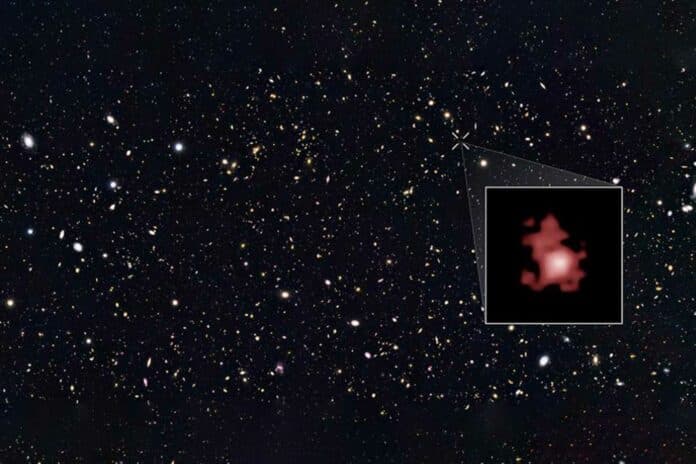Scientists have put forth various theories to explain how black hole seeds formed in the early Universe and to account for the existence of extremely massive black holes observed within the first billion years after the Big Bang. These models explore different scenarios for the initial formation of black holes and how they gather mass through accretion.
To validate these models, detecting and characterizing black holes that existed in the first few hundred million years after the Big Bang is essential.
The international team, led by the University of Cambridge, used the NASA/ESA/CSA James Webb Space Telescope (JWST) to detect the black hole, which dates from 400 million years after the Big Bang, more than 13 billion years ago. This is the oldest black hole ever observed, dating from the dawn of the Universe, and found that it is ‘eating’ its host galaxy to death.
The discovery of this newly found black hole implies that there might be alternative ways for these cosmic entities to form. They could either be “born big,” suggesting that some black holes start with a significant mass right from their inception, or they could increase by consuming matter at a rate much higher than previously believed.
According to conventional models, supermassive black holes typically form from the remnants of deceased stars. These remnants collapse and may give rise to a black hole approximately a hundred times the mass of the Sun. If the black hole were to grow as expected, reaching the size observed in this recent discovery would take about a billion years. However, the Universe was not yet a billion years old when this black hole was identified.
Lead author Professor Roberto Maiolino says, “It’s very early in the Universe to see a massive black hole, so we’ve got to consider other ways they might form. Very early galaxies were extremely gas-rich so that they would have been like a buffet for black holes.”
Like all black holes, this newly discovered young black hole is consuming material from its host galaxy to fuel its growth. However, it is unique because it devours matter much more vigorously than other black holes at later stages of their development.
The young host galaxy, GN-z11, shines brightly due to the intense activity of this early black hole at its center. Black holes cannot be observed directly, but their presence is indicated by the distinctive glow of a swirling accretion disc that forms near the edges of the black hole. The gas in this disc becomes extremely hot, emitting energy in the ultraviolet range, which astronomers can detect.
GN-z11 is a compact galaxy, only about one hundred times smaller than the Milky Way. However, the highly active black hole is likely hurting the galaxy’s development. When black holes consume excessive gas, they generate an ultra-fast wind that pushes the gas away. This mighty ‘wind’ can hinder the star formation process, gradually harming the galaxy. Importantly, it also poses a threat to the black hole itself, as it cuts off its source of ‘food,’ potentially leading to the demise of both the galaxy and the black hole.
Maiolino says that the gigantic leap forward provided by JWST makes this the most exciting time in his career. “It’s a new era: the giant leap in sensitivity, especially in the infrared, is like upgrading from Galileo’s telescope to a modern telescope overnight,” he said. “Before Webb came online, I thought maybe the Universe isn’t so interesting when you go beyond what we could see with the Hubble Space Telescope. But that hasn’t been the case: the Universe has been quite generous in what it’s showing us, and this is just the beginning.”
“The sensitivity of JWST means that even older black holes may be found in the coming months and years. Maiolino and his team hope to use future observations from JWST to try to find smaller ‘seeds’ of black holes, which may help them untangle the different ways that black holes might form: whether they start out large or grow fast.”
Journal Reference:
- Maiolino, R., Scholtz, J., Witstok, J., Carniani, S., De Graaff, A., Übler, H., Tacchella, S., Arribas, S., Bunker, A., Charlot, S., Chevallard, J., Curti, M., Looser, T. J., Maseda, M. V., Rawle, T., Willott, C. J., Egami, E., Eisenstein, D., Hainline, K., Sun, F. (2024). A small and vigorous black hole in the early Universe. Nature, 1-3. DOI: 10.1038/s41586-024-07052-5
